Made in Slovenia
STA, 9 December 2019 – The British business newspaper the Financial Times has ranked the University of Ljubljana's School of Economics and Business among the 95 best business schools in Europe for the second consecutive time [at 89]. The faculty sees this achievement as a recognition of its quality in the international arena.
The Financial Times has thus put Slovenia on the map of top-quality business education, said the Ljubljana-based faculty when it first made the cut.
The ranking requires having at least one of the top international accreditations - the AACSB and EQUIS-accredited Ljubljana school has both as well as the AMBA accreditation, while its International Master in Business programme has been ranked as one of the best business programmes.
The faculty pointed out that its students had at their disposal exchange programmes at five foreign business schools which had also made the grade, including French KEDGE, Norwegian BI, French Audencia, Portuguese ISCTE and French ESSCA.
The Ljubljana School of Economics and Business also hosts a PhD summer school programme along with the Swiss St. Gallen University business school, which traditionally ranks among top four schools according to the Financial Times. It also takes part in the EUTOPIA partnership of six European universities.
All our stories about the University of Ljubljana are here, while the full FT rankings can be found here
STA, 6 December 2019 - Following years of efforts by researchers, a project was launched to design the first monitoring of the most important wild pollinators - wild bees - in Slovenia. Their role has long been neglected even if they are more effective pollinators than honeybees. Slovenian scientists would like to better understand them, and to do that they will apply machine learning methods.
Pollinators are key to both agriculture and the preservation of natural ecosystems. Although honeybees used to be considered the most important pollinators, it has become clear that it is crucial to have a variety of pollinators; wild pollinators such as bumblebees are for instance more efficient pollinators than honeybees.
Due to their short tongue, honeybees tend to avoid blossoms with a longer neck, which are pollinated by bumblebees. Bumblebees are particularly important for plants which require blossom shaking to be pollinated, for instance key crops such as tomatoes and blueberries, and another 16,000 plants. They are also indispensable for plants with very deep blossoms, which honeybees cannot pollinate with their short tongue, said Danilo Bevk from the National Institute of Biology.
Bumblebees are also special in that they fly around in bad weather, which is quite often the case when fruit trees are blossoming in the spring. "This is one of the reasons why we could say that they are the most important wild pollinators, although others, such as solitary bees, flower flies or butterflies are also important," said Bevk.
Keeping bumblebees as a hobby
While beekeeping is a very popular pastime in Slovenia, bumblebee-keeping is much less widespread, with only slightly more than 180 people keeping bumblebees in their gardens. One of them is Janez Grad, a doctor of mathematics and retired professor emeritus of computer science of the Ljubljana Faculty of Economics, who has had bumblebees in his garden behind his home for 35 years.
Every year about seven species of bumblebees find their home in his garden. "Queen bumblebees fly back to their hives after hibernation, just like swallows come back to their nest," said Grad.
Only bumblebee queens hibernate
Bumblebee hives in Grad's garden are empty in the autumn, as the animals go into hibernation, which usually lasts seven months. Only bumblebee queens from the past season survive winter, having dug into soil in the woods, away from people, animals and light, hibernating until early spring when new bumblebee families, worker bees, male bees and new bumblebee queens emerge.
The development of a bumblebee family depends on weather. If spring arrives early, new bumblebee families can appear at the end of February. But an early and warm spring followed by a cold spell disaster. In this case bumblebee queens leave their nest, leaving behind their brood. Once they return after the cold spell is over, it is often too late. This year May was cold and rainy, which Grad, one of the greatest experts on bumblebees in Slovenia, said would be felt next year.
People, disease and climate change pose a threat to bumblebees
Climate change is one of the most serious threats to bumblebees and will affect the majority of bumblebees in Europe. Researchers expect that as a result of anticipated climate changes, almost half of all bumblebee species could lose 50-80% of their territory by 2100, said Bevk.
"However, for some species changes will be an opportunity. A Mediterranean bumblebee spread here a decade ago probably due to climate change. Climate change will of course have a negative impact on pollination, so it is even more important to preserve a high degree of diversity of pollinators."
Various diseases, and some birds which eat bumblebee queens in spring, are another threat to bumblebees. However, Grad said that people are enemy No. 1 of bumblebees, destroying their habitat with intensive agriculture, frequent and early grass cutting, and with the use of pesticides.
First monitoring of solitary bees and bumblebees
Sixty-eight species of bumblebees have been discovered in Europe, of which a quarter are at risk of extinction. Half the populations are in decline, Bevk explained. There are 35 species in Slovenia, and while some of them have not been noticed for quite a while, their extinction cannot be proved because there has been no wild bee monitoring in Slovenia yet.
In November, after five years of efforts by researchers, a project was launched to design the monitoring of wild bees - solitary bees and bumblebees - in Slovenia.
"The project aims to develop a methodology of wild bee monitoring, launch test monitoring at selected locations, assess the situation of wild bees and draft guidelines for sustainable monitoring of wild pollinators in Slovenia," explained Bevk.
The National Institute of Biology, which is in charge of the project, believes this will enable them to gather hard data about the movement of bumblebee and solitary bee populations in our country, which is of key importance in designing adequate measures to protect and monitor the efficiency of these important pollinators. Regular monitoring could make Slovenia a leader in this field in Europe, the institute said.
Machine learning to study bumblebees
An important contribution to better understand bumblebees has been made over the past few years by researchers from the Jožef Stefan Institute's department for intelligent systems, which has been researching buzz sound and temperature in close collaboration with Professor Grad.
Grad contacted the Jožef Stefan Institute a few years ago asking for help in analysing the bumblebee buzz which he had recorded in previous seasons, explained researcher Anton Gradišek. With the help of Grad's recordings, the institute developed an app which draws on machine learning and which, using advanced computer methods, recognises which bumblebee species makes which buzz sound, and whether the sound is made by a queen or worker bee.
Researchers at the institute are not the first to study bumblebees, but their research is different in that it is carried out in nature, in Grad's garden rather than in a controlled lab environment. Gradišek said the garden proved to be an excellent natural laboratory, enabling them to study not just a few of the most interesting species but a number of different ones.
The institute is researching different aspects of bumblebees, including sound and temperature. Sound research has resulted in a new simple method to record bumblebee flight to establish when bumblebees are more active, which depends on the species.
As part of the research into temperature, small temperature sensors and thermometers are put in hives to monitor how well bumblebees can keep temperature, which is important for the development of larvae. If the temperatures is adequate, the larvae develop properly, whereas an environment too hot or too cold affect the development of the colony.
"The research has shown that we can recognise different species of bumblebees quite well, which is important for further studies of biodiversity. The temperature research is interesting from the aspect of climate crisis and its impact on the development of bumblebees," said Gradišek.
The researchers would also like to study communication in the nest, for instance how bumblebees let others know the location of the food in the nest, which bees do with waggle dance. They would also like to know how changes in temperatures in the nest and its surroundings affect their activity.
If you’re in the euro zone and have some coins then there’s a chance you’ve got some icons of Slovenia in your pocket. This is because the EU allows countries to choose their own designs for the reverse sides of coins, and back in 2004 and 2005 Slovenia chose eight, one for each denomination. (Although if this comes up on quiz night, note that the country didn’t start using the currency until 1 January 2007.)
Each design represents something from Slovenian culture, which we’ll present below should you decide to take an interest in numismatics and want to collect the whole set, or find yourself left to your own devices, without a phone, friend or book, and only a pocketful of change for entertainment.

France Prešeren, the 19th century poet, appears on the two euro coin, as befits the man whose words would go on to become the Slovenian national anthem. Since there’s no attested authentic portrait of the man, despite the images of him you’ll often see, and the statue that stands in his namesake square in Ljubljana, his face is only shown in silhouette. However, the first line of the poem that’s used in the Slovenian anthem is shown in his handwriting: Žive naj vsi narodi (May all nations live).

Primož Trubar (1508 – 1586) is the other literary figure shown on Slovenian coinage, the author of the first two books printed in the Slovene language, Catechismus and Abecedarium, a religious work and one to help people learn the alphabet, respectively. Along with the man’s portrait the coin bears the words Stati inu Obstati (To exist and persevere).
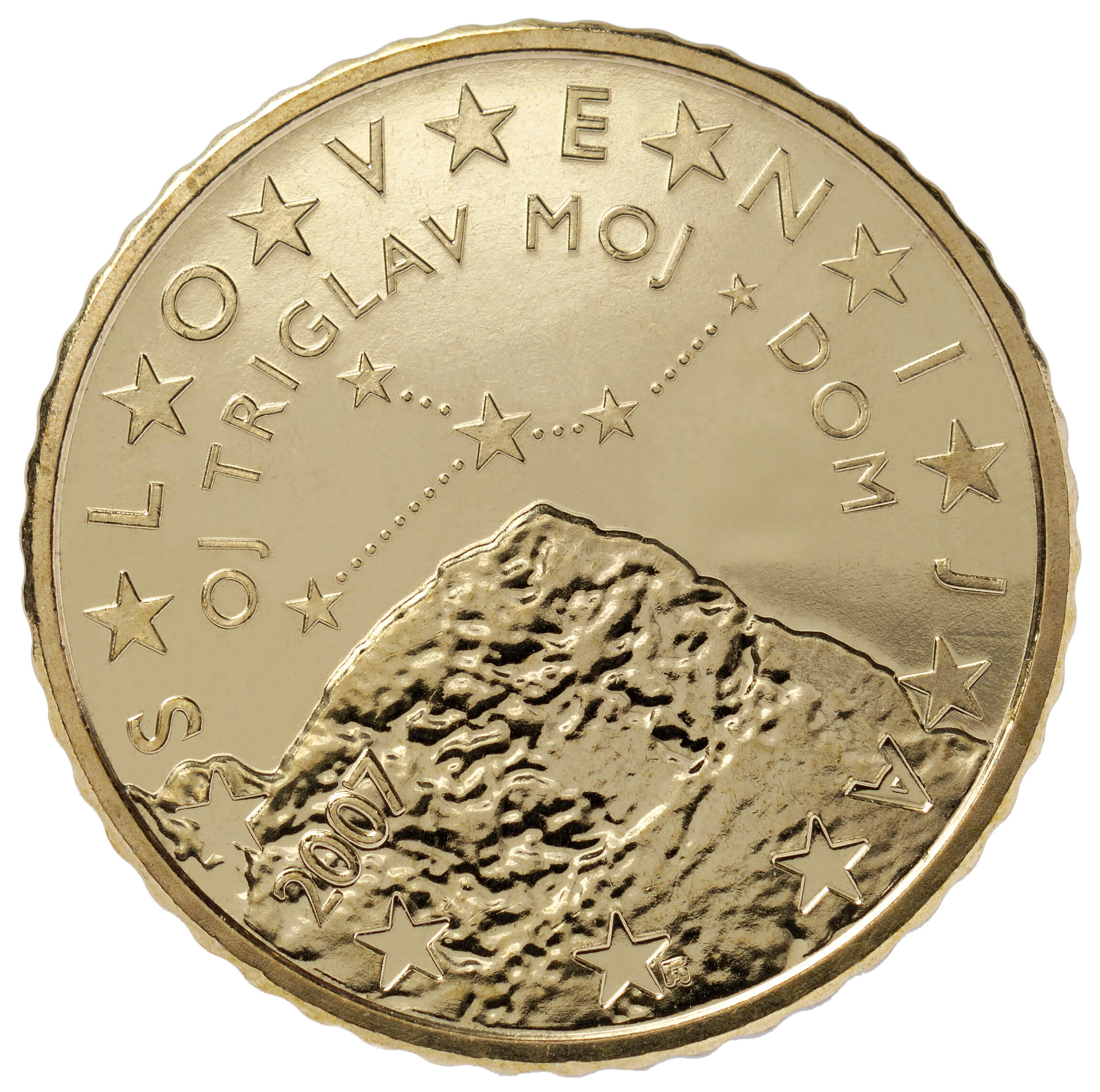
Triglav is the tallest mountain in Slovenia, and “all true Slovenes” are supposed to climb it at least once in their lives. The triple peak, which is easier to see in stylized representations that real life, was used as a symbol by those fighting against occupation in World War 2 and can be seen on the Slovenian flag. Also shown on the coin, above the peak, is the constellation of Cancer, the sign of zodiac under which the nation finally achieved independence, on 23 December 1990. The inscription reads Oj Triglav moj dom (Oh Triglav, My Home).
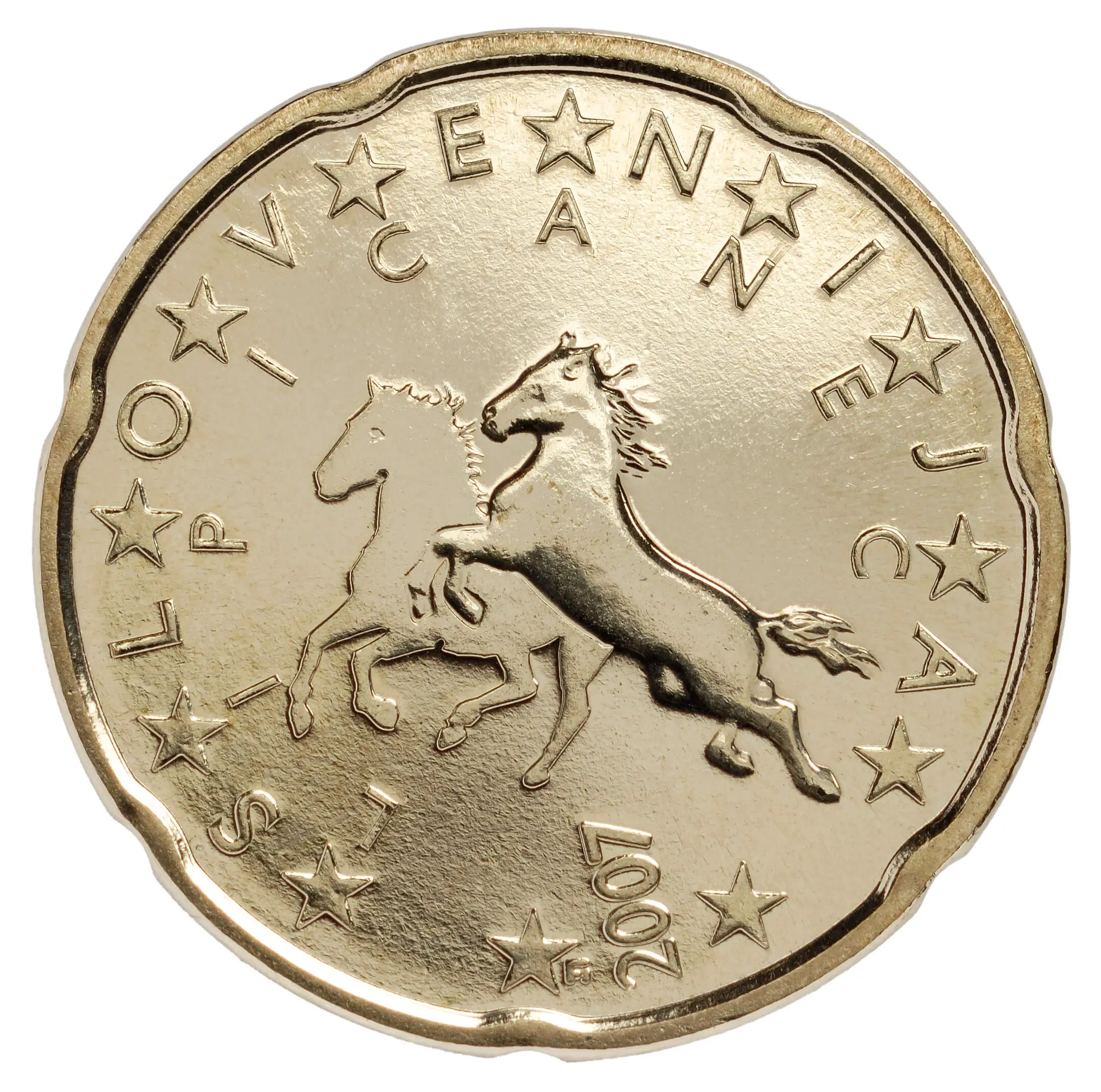
While Austria makes a claim to Lipizzaner horses, because they served the imperial court under the Austro-Hungarian Empire, they were (and are) bred and trained in Lipica. The 20-cent coin shows two of them at play. The inscription says Lipicanec, or Lipizzaner.
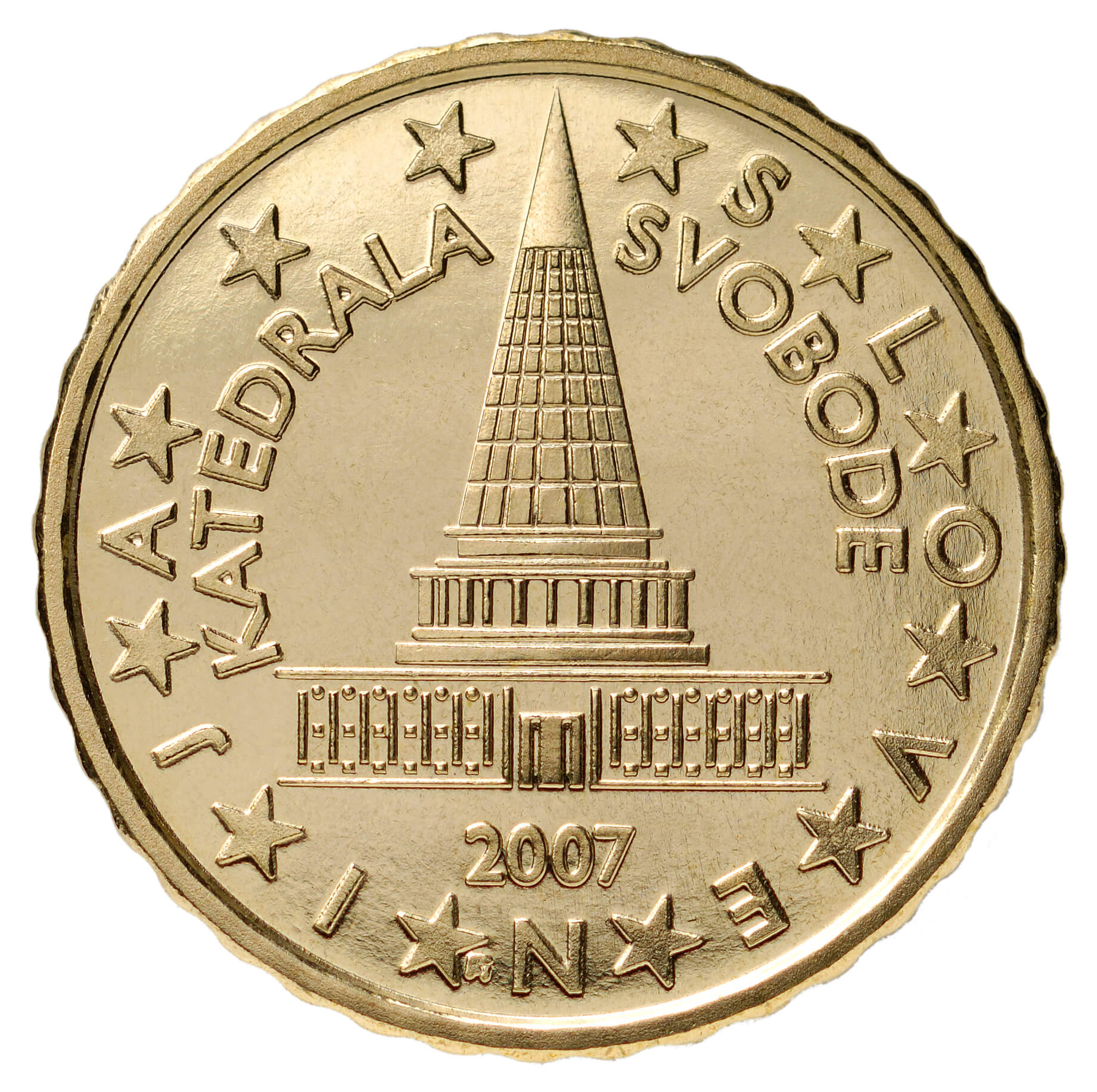
Jože Plečnik is the architect mostly closely associated with Ljubljana, responsible for the Triple Bridge, Križanke, the Central Market, the Arcades, the National University Library and more (although not Dragon Bridge). The 10-cent coin shows one of his many unrealised and perhaps overambitious works – a structure formally known as the Slovene Acropolis or Cathedral of Freedom (Slovenska akropola / Katedrala svobode), with that latter name appearing along with the image. You can see more of Plečnik’s unrealised works for the city here.
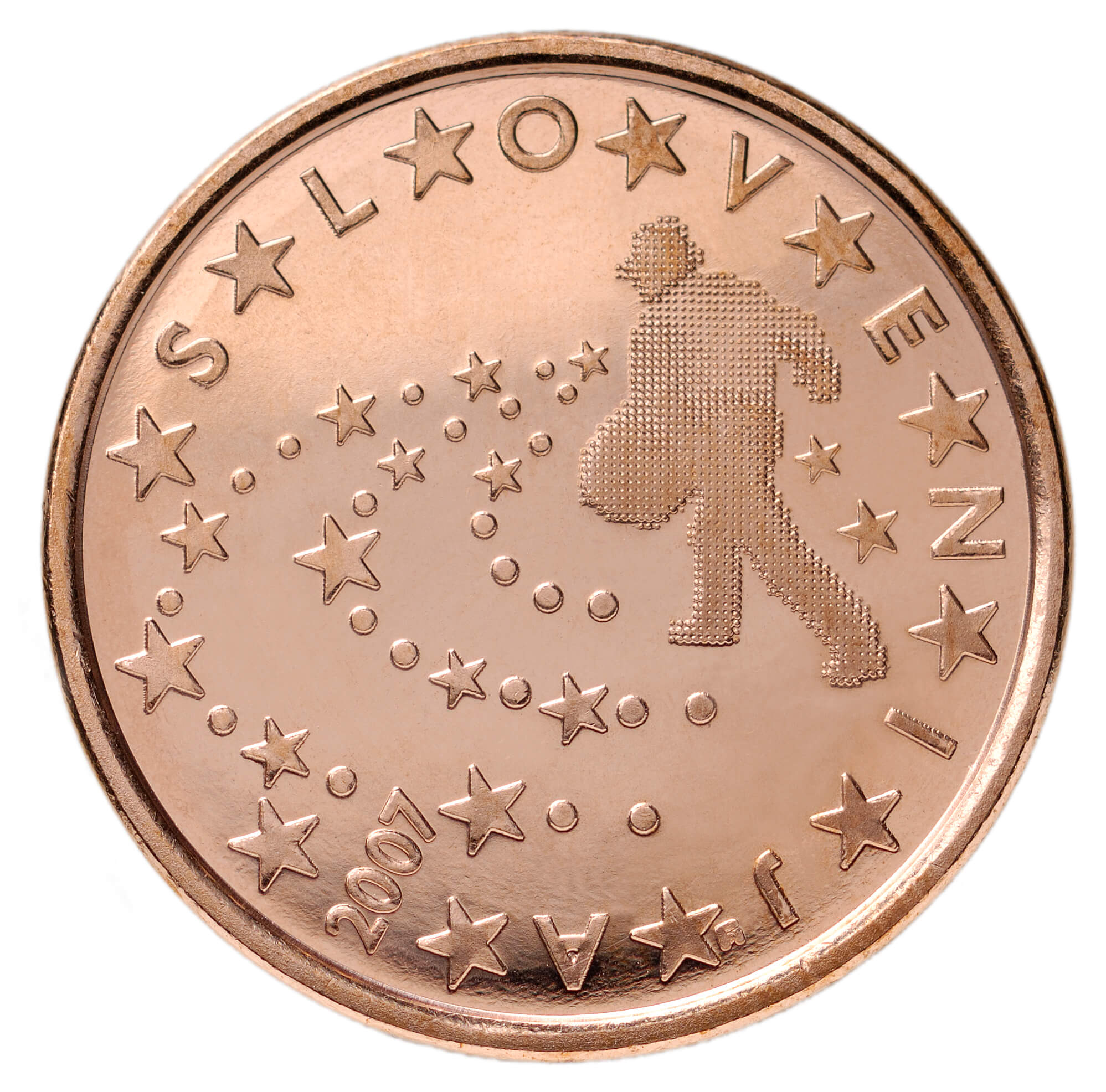
The five-cent coin shows a man sowing seeds in a field, which – according to the Bank of Slovenia – represents the moment when a farmer is closest to God. The design is based on a famous painting called The Sower (Sejalec) by the Slovene impressionist Ivan Grohar, with can be found in the National Gallery.

This unassuming looking stump is in fact “the Prince’s Stone” (knežji kamen), the reversed base of an ancient Ionic column, thought to be from the Roman city of Claudium Virunum (today’s Zollfeld, Austria), which was used in the ceremony for the coronation of the Dukes of Carinthia.
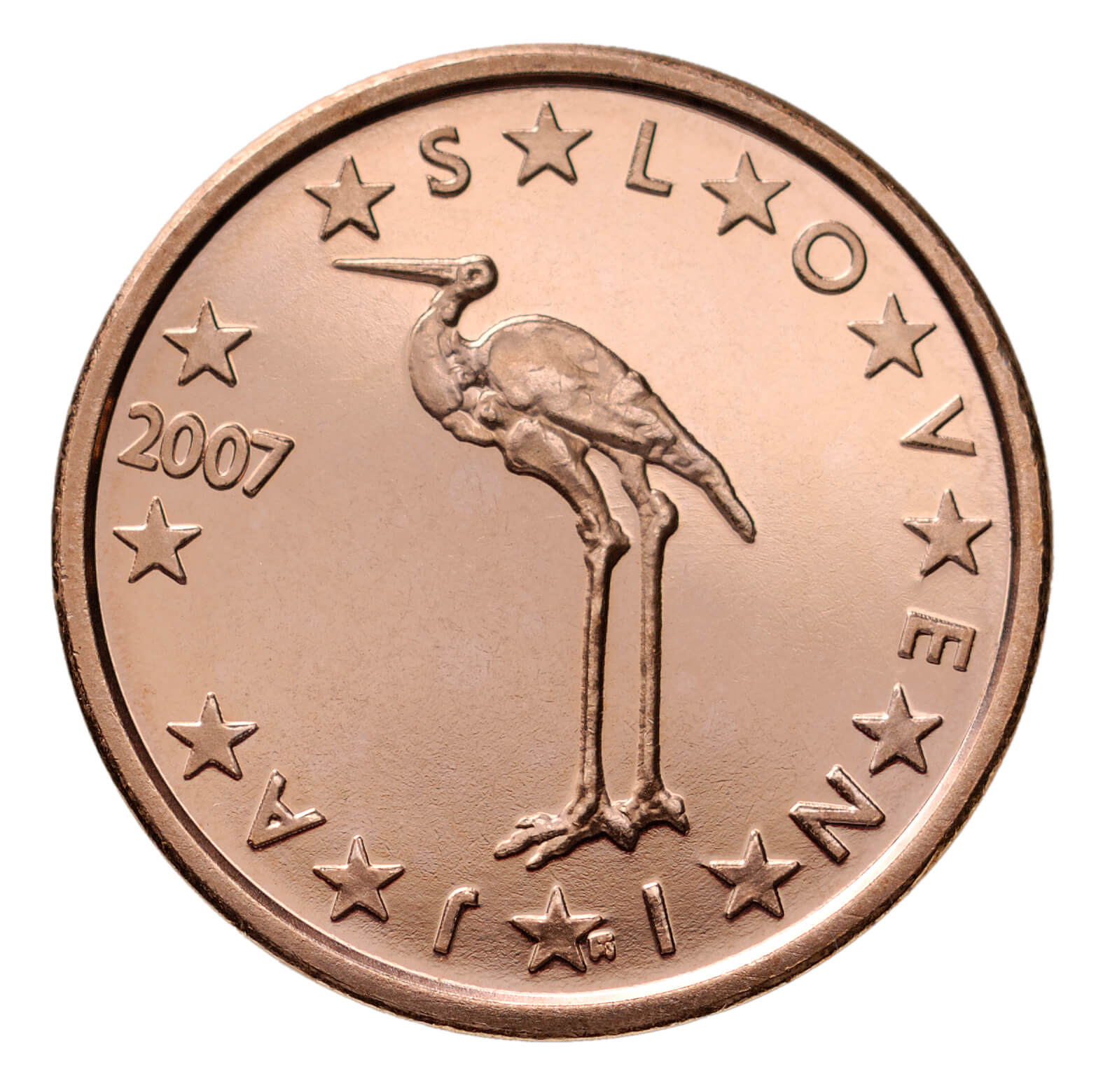
The stork shown on the humble one-cent coin is a vestige of Slovenia’s pre-euro currency, the tolar, which lasted from 8 October 1991 to 1 January 2007. This motif originally appeared on the 20 tolar coin.
Related: A brief history of money in Slovenia
STA, 3 December 2019 - Three Slovenian projects developing research infrastructure for international competitiveness of Slovenia have won a total of EUR 8.4 million in subsidies from EU funds. The projects are related to the priority areas of the research infrastructure development of the national smart specialisation strategy.
LifeWatch, a EUR 3.3 million project intended for the purchase of equipment which will enable international research projects for monitoring and projecting the effects of global changes on biodiversity to be continued, will get EUR 2.6 million from the European Regional Development Fund.
The research infrastructure will enable the collection, processing and storage of data on biodiversity, the Government Office for Development and European Cohesion Policy said in a press release on Tuesday.
A bank of tissue samples, an analytical centre and a molecular laboratory with software for analysis of genetic diversity and genomics and biotechnology instruments will also be established as part of the project.
Eatris, a EUR 2.4 million project aimed at modernising research infrastructure serving for early phases of development of pharmaceuticals and development of the latest diagnostic methods and therapeutic approaches, will get EUR 1.6 million in EU funds.
The projects includes genome and metabolome technologies which are, due to their application-oriented nature, also called translational research. This will improve Slovenia's competitiveness as part of the European Research Area and European research infrastructures.
Also receiving EUR 4.2 million from the European Regional Development Fund is Elixir, a EUR 5.3 million project intended for boosting the national research capacity in life sciences. It will provide infrastructure for a more efficient transfer of new knowledge to healthcare and industries related to biological processes.
The infrastructure enables effective integration of consortium partners with related partners in other national infrastructures in natural sciences, life sciences and advanced computer technologies, the government office said.
STA, 3 December 2019 - The University of Ljubljana, Slovenia's largest institution of higher learning, is celebrating its centenary with a series of events that culminated on Tuesday, the day exactly 100 years ago when the first lecture was delivered in the Slovenian language.
The university awarded out a doctorate to Kenneth Brian Frampton of Columbia University in New York today and will hold a special ceremony in the evening when it will receive the Order of Merit for Distinguished Service from President Borut Pahor.
The university started out with five founding members - the faculties of arts, medicine, law, technology and theology - after King Alexander signed a law establishing what was then the University of the Kingdom of Serbs, Croats and Slovenes in Ljubljana.
The first lecture was delivered in the building that remains the seat of the university to this day, the former Carniolan Provincial Court in the centre of Ljubljana, by the linguist Franc Ramovš and the topic was the historical grammar of the Slovenian language.
In the first academic year the university boasted almost a thousand students and by the start of the Second World War enrolment had increased to almost 2,500.
While male students far outnumbered women in the first years, the first person ever to get a doctorate was a woman, Ana Mayer, who received her PhD in chemistry in July 1920.
The university continued to grow after the Second World War and by the 1960s it already had nine faculties. In 1979 it was renamed to Edvard Kardelj University, in honour of the Slovenian Communist ideologue, but in 1990 it reverted to the University of Ljubljana.
After independence, especially under the 1993 higher education act, it transformed into what it describes as a "classical European university," with greater emphasis on scientific research and greater autonomy.
It presently comprises 26 faculties and academies and its 38,000-plus students are enrolled in 158 bachelors', 196 masters' and 21 doctoral programmes ranging from the arts to social sciences, natural sciences, engineering, medicine and law.
"A hundred years later we are a university that has gone beyond national borders and helps build the European university of the future," Chancellor Igor Papič told the STA.
He said the University of Ljubljana ranks among the top three percent of universities in the world, which was "probably unimaginable a century ago, when we were fighting to get the university in the first place and faced constant pressure that it be shut down."
In the latest Shanghai Rankings, considered a benchmark for higher education institutions, the university ranks 501-600, down from 401-500 last year.
At the ceremony today Papič said that the university was "in excellent shape". While it wants better financing, it is glad it does not currently have problems paying salaries. The main challenge at the moment is securing funds for the construction of several new faculty buildings and cutting-edge research equipment.
STA, 1 December 2019 - An idiosyncratic graphic novel that was originally released in instalments on Facebook has won the Grand Prix for book of the year at the Slovenian Book Fair.
"Vinjete Straholjubca" (The Bête Noire Vignettes) is a joint project by writer Eva Mahkovic and illustrator Eva Mlinar, and the first original Slovenian release by VigeVageKnjige, a publisher specialised in translations of comics and graphic novels.
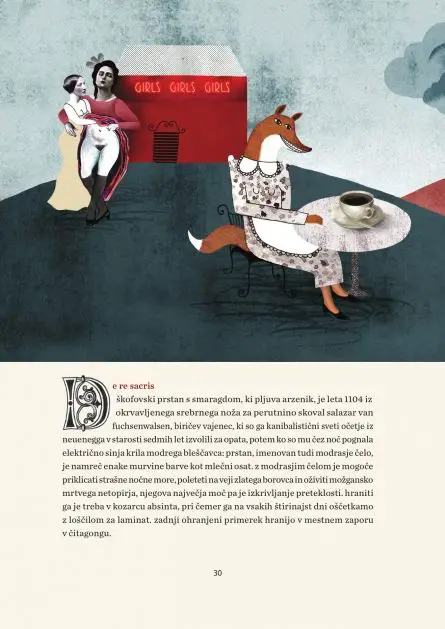
Originally a series of short snippets posted on Facebook between 2011 and 2015, the project morphed into a loosely connected collage of horror stories that the publisher describes as "an attempt to create a literary and visual collection of the grotesque of an elusive genre".
The Book Fair jury, comprising literature lovers as well as industry professionals, described it as an "intimate and provocative manifestation of a tangle of lucid ideas by two authors".
The authors have created a rich fantastic world of their own, but they also draw profusely on sources including the Bible, William Shakespeare, Truman Capote and Umberto Eco.
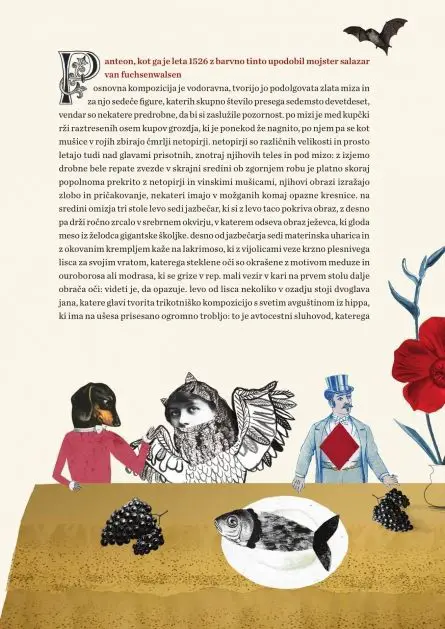
The book is "controlled down to the last detail, enhancing the reader's experience of encountering the emerging genre of the graphic novel," according to jury member Domen Fras, a graphic designer.
The award is not confined to any one genre, all books published between 1 October 2018 and 30 September 2019 were eligible. The works were judged as integral pieces of art, with the jury considering not just the stories but also layout, language, graphic design, illustration and photography.
The winner was selected by Slovenian Book Fair visitors from among a shortlist of five very diverse works which included a literary guide to Istria, a poetry collection, and a collection of Facebook posts by Mahkovic, the only author with two shortlisted works.
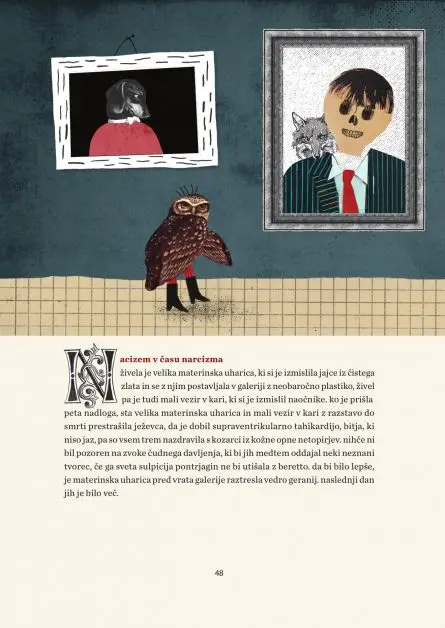
Jury member Nina Kožar said the selection was accidentally heavy on books that were created on modern platforms: three started out on Facebook and one seems like it did.
The award was conferred on the last day of the 35th Slovenian Book Fair on Sunday.
You can buy the book online and direct from the publisher here
STA, 29 November 2019 - The British Broadcasting Corporation (BBC) on Wednesday evening aired a documentary about the 106-year-old Boris Pahor, believed to be the oldest living survivor of a Nazi concentration camp. Pahor, one of the most celebrated Slovenian writers, talks about life and death at the Natzweiler concentration camp.
Pahor tells BBC journalist Alan Yentob about his experiences with Fascism and Nazism in the 63-minute documentary The Man Who Saw Too Much, which is aimed at raising awareness of the horrors that happened in Europe more than seven decades ago.
The BBC crew visited Pahor at his home in Trieste. "Boris, a Slovenian, was born in the tolerant, cosmopolitan city of Trieste in 1913. After World War I, when it became part of Italy and Mussolini rose to power, fascists burned down the Slovenian cultural centre, closed their schools and the speaking of Slovenian in public was banned," BBC says on its website.
In the interview, Pahor remembers in Slovenian the events from 1944, when he was 30 years old. He was arrested by the Gestapo, beaten and forced into a small closet where he thought he would suffocate.
He was then sent to concentration camps. He stayed the longest in Natzweiler in the mountains of Alsace. Nearly half of its 52,000 prisoners died due to forced labour, malnutrition, illness and execution.
Natzweiler was the first concentration camp in western Europe to be discovered by the Allies - but the camp was empty, its prisoners had already been taken to Dachau by then.
"Pahor's harrowing descriptions are illustrated with remarkable drawings by fellow prisoners, creating a unique record of conditions in the Nazi death camps. His testimony, along with details from a shocking report into the camp by British intelligence officer Captain Yurka Galitzine and the chilling testimony by SS commandant Josef Kramer, infamous as the Beast of Belsen, combine to tell an extraordinary story," according to the BBC.
Pahor also mentions a section from his best-known book Necropolis about his return to the camp site 20 years after its liberation to find a luxury ski resort there and tourists who knew nothing of the place's past.
Sections of Pahor's books are read out in the documentary aired 75 years after the allies first discovered the horrors of Holocaust by breaking into Natzweiler shortly after the departure of Nazis.
Although the documentary was aired late in the evening, many watched it, and shared their observations on social networks.
It also obviously prompted many to read Necropolis, as Amazon ran out of copies almost immediately.
The documentary will be available on the BBC's website the entire month, but only in the UK.
STA, 27 November 2019 - The first stage of Slovenia's fastest public supercomputer was officially launched as part of the EuroHPC network of supercomputers at the University of Maribor on Wednesday.
The HPC RIVR is a prototype that will be used to develop and test solutions for the primary supercomputer system at the Institute of Information Sciences (IZUM), which is expected to be launched at the end of 2020.
The supercomputer in Maribor is one of EU's eight high-performance computing (HPC) centres, the others being located in Bulgaria's Sofia, Czech Republic's Ostrava, Finland's Kajaani, Italy's Bologna, Luxembourg's Bissen, Portugal's Minho and Spain's Barcelona.
The centres will provide support to the research community and industry in developing know-how and knowledge applications in medicine, advanced materials and climate change combat.
The prototype stage launched today, called Maister after the WWI general Rudolf Maister, has 4,256 processor cores and a capacity of 244 TeraFLOPS.
The final supercomputer, called Vega after the 18th century mathematician Jurij Vega, will have a capacity of 10 PetaFLOPS and over 100,000 processor cores with an added field of 600,000 GPU cores once it is built at the Institute of Information Science (IZUM).
If it was launched today, Vega would rank 20th among the world's most powerful supercomputers, but by the end of next year it is expected to place around 40th place, according to Miralem Hadžiselimović, vice-chancellor of the University of Maribor.
The project is coordinated by the University of Maribor, but all public institutions from the Slovenian national supercomputing network (SLING) are involved.
The entire project, valued at EUR 20 million, is mostly funded by the EU (80%), while the Ministry of Education, Science and Sport will chip in the rest.
University of Maribor chancellor Zdravko Kavčič said the project was very important for the entire country. "It puts not just universities and research institutions but the entire corporate sector in a new role where it is capable of competing in Europe and globally with own know-how," he said.
STA, 25 November 2019 - The first UNESCO-sponsored international centre for artificial intelligence (AI) will be seated in Slovenia's capital Ljubljana, the UNESCO conference general decided in Paris on Monday. The International Research Centre for Artificial Intelligence (IRCAI) is to be established early next year.
The Slovenian ministry in charge of education and science believes this puts Slovenia on the global map of the most high-profile and advanced countries AI-wise.
"The centre is a recognition to Slovenian scientists' achievements and a result of the good cooperation between the Slovenian government and UNESCO, especially in open educational resources, an area where Slovenia has gained recognition as a global leader.
"The centre will put Slovenia at the top of global technological developments," the Ministry of Education, Science and Sport said in a release.
The UNESCO conference general unanimously endorsed Slovenia's bid for the AI centre today after UNESCO's executive board endorsed it in April.
Slovenia plans to found the IRCAI at the start of 2020, when an agreement on its establishment is signed by the ministry and UNESCO.
The IRCAI will be the first UNESCO-sponsored global AI research centre, also serving as a role model for similar centres to be set up around the globe.
The ministry said a number of countries and international organisations had already expressed interest in working with the new centre.
The new facility will aim to provide an open and transparent environment for AI research and debates on AI, providing expert support to stakeholders around the globe in drafting guidelines and action plans for AI.
It will bring together various stakeholders with a variety of know-how from around the world to address global challenges, support UNESCO in carrying out its studies and take part in major international AI projects.
The centre will advise governments, organisations, legal persons and the public on systemic and strategic solutions in introducing AI in various fields.
Helping to expand AI capacities around the world, including by establishing auxiliary research centres and drafting training programmes, will also be among its tasks.
The UNESCO general conference also decided today that ethics recommendations for AI should be drafted by the next conference general, scheduled for 2021, a project in which the Ljubljana-based centre will also take part.
STA, 25 November 2019 - Slovenian scientists have decoded the genome of the olm, an endemic cave-dwelling aquatic salamander, based on which new possibilities could be developed in healthcare, for example to heal wounds, understand the causes of obesity and treat diabetes, a press conference heard in Ljubljana on Monday.
The discovery of the genome of the animal found in the karst caves of the Western Balkans, including southern Slovenia, has been made in cooperation with the Danish researchers and the Chinese institute BGI Research.
The olm or proteus, nicknamed the "human fish", is interesting to scientists from the genetic perspective as it can live up to 100 years, and is able to survive long periods without food or overeating without damage to its organs.
12 Things to Know about the Olm, Proteus, Human Fish & Baby Dragon
It also has exceptional capabilities of regeneration, as it is able to regrow an amputated limb, which could be recently witnessed by visitors to the Postojna Cave in Slovenia.
The project to determine its genome was launched last March at the University of Ljubljana together with researchers of Aarhus University in Denmark and BGI Research. Tissue from two olms were sampled, frozen and sent to China.
Duncan Yu, the director of MGI, a subsidiary of BGI Research, told the press that determining the genome had been a complex task requiring a combination of state-of-the-art technologies, as it was 15 times larger than the human genome.
More than a trillion nucleotides, the basic building blocks of DNA and RNA, have been determined, and each of them have been read 160 times on average, with the information obtained now being merged into the final genome sequence.
Yu handed over today a recording of the genome sequence, which bears 42 Megabytes of information, to Igor Papič, chancellor of the University of Ljubljana.
The decoding of the genome is expected to make it easier for scientists to understand how the olm manages to survive years without food or to overeat without any negative effects on the organism.
According to Rok Kostanjšek of the Ljubljana Biotechnical Faculty, who heads the project in Slovenia, it will be easier to understand metabolic processes and apply the findings in human medicine.
In humans, fasting triggers insulin resistance, which leads to diabetes, while this does not happen in the olm, he said, adding that the findings could perhaps be used to improve diabetes medications.
The understanding of the olm's ability to regrow an amputated limb will probably not lead to this being possible in humans, but it could lead to new findings in the treatment of wounds and shorten hospital care after surgeries.
Kostanjšek added that the insight into the genome would also provide scientists with a new basis for discovering or understanding mechanisms related to longevity and genetic diversity.
Analyses of the genome could also be used to determine the sex of an individual olm, which is important for the preservation of this endangered species, as their mating could be facilitated under controlled conditions.
The information could furthermore be used to find out how many populations of the olm exist in a certain area, which would speak about the stability of these populations.
STA, 21 November 2019 - Gregor Božič, whose feature debut Stories from the Chestnut Woods (Zgodbe iz kostanjevih gozdov) swept eleven awards at the Festival of Slovenian Film, has spoken to the STA about what is considered a ground-breaking achievement of Slovenia cinema. Božič dedicated the emigration-themed historical picture, shot on film, to neglected places and people.
The Slovenian-Italian co-production, going into general release in Slovenia after the end of the Ljubljana International Film Festival, was written by Božič and co-writer Marino Gumzi, who drew on Anton Chekhov's short stories and the post-WWII period in Benečija in the border area between Slovenia and Italy.
The up-and-coming director spoke passionately about the architecture and haunting remains of the region's abandoned villages.
"The most interesting thing about these villages was why they had been abandoned. It was all very mysterious," said Božič, whose family partly originates from the region's Brda area.
"I remember that local photographers used to go to these villages frequently and document all that had been left behind, by people who were literally leaving over night after 1954, trying to reach the US, Australia or other places through secret routes."
Božič had made trips to the region, also known as Terra delle Castagne or chestnut land, while researching old fruit varieties, but what stayed with him the most were the stories that locals shared with him in the company of a glass of wine.
Another thing was the specific atmosphere of the landscape, its "steep slopes, a river diving it, all of it in a fairly condensed location, it practically looked like a studio in nature to me".
Speaking about some of the incredible stories heard, he noted not all of the moments could be included in the film, "for instance one about how the brothers arrive home and the polenta is cooking on the stove, while the sister is simply gone over the border, for ever".
"And departing is also the main theme of the film, both of people to other places and in the sense of a final farewell, death. At the same time the film is an homage to neglected places and people living there."
While moreover speaking of references to the uncertain fate of these people looking for a better life, Božič said the makers of the film had also explored the parallels to today's reality and "the decomposition of the social fabric".
"For us, this was a story about a community that is pushed by economic circumstances to a point where culture is no longer important; what is important is counting money, which is something the carpenter Mario is doing in the film.
"Nothing good can come of a situation when people no longer talk to or hear each other. It is the circumstances that lead people to cynicism, bitterness. In the film it seems that such relations in the province are a personal affair, but the truth is that these are wider systemic issues."
Meanwhile, commenting on the film's chiaroscuro-inspired cinematography, Božič said it had all occurred very spontaneously, the cooperation with cinematographer Ferran Paredes Rubio also being the result of the director looking for somebody to separately look after the light while he would worry about composition.
"We made a very good team when it comes to achieving this light/dark effects. The scenographers and custom designers also deserve immense credit," he said.
Božič moreover defended the choice of 16-millimetre and 35-millimetre film as a method that in fact saves costs.
"I always say this to anyone telling me that shooting on film is expensive today. A lot of post-production work would have been needed had we attempted to achieve these effects with a digital camera, which of course means extra costs. This was definitely one of the best decisions we made."
Božič, who is likely to dedicate his next film "to much more modern topics", is presently working on a documentary about the perception of fruit today, about "the loss of an incredible wealth of tastes and forms that used to inspire farmers, artists and kings".




